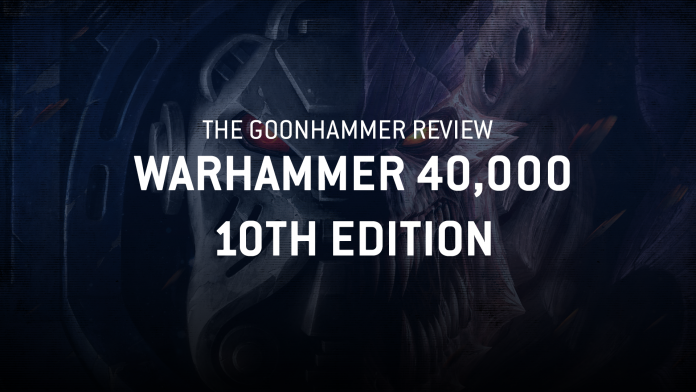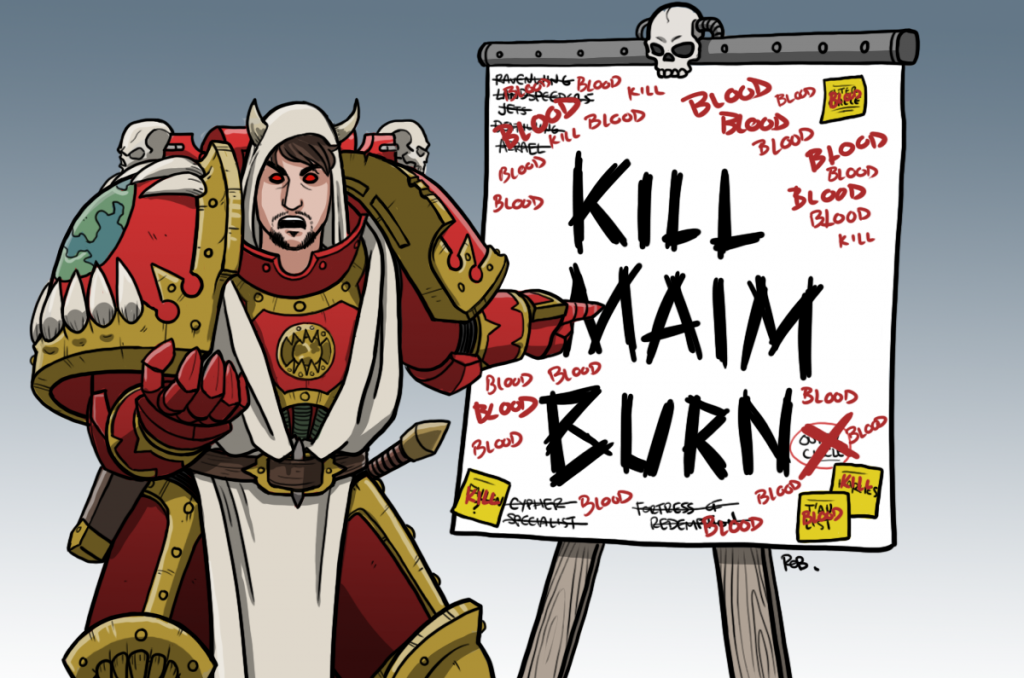10th Edition already has its first GTs in the books, but we’re not done with the launch content just yet. Today Games Workshop published the Leviathan Tournament Companion (LTC), a free online document providing a mixture of advice and rules changes for using the Leviathan Mission Pack in competitive play. If you’re planning on hitting any tournaments in the foreseeable future this is big news, so join us as we delve into it and find out how it’s going to shake things up.
Before we dive in we’d like to thank Games Workshop for providing us with a preview copy of the rules for review purposes.
The Overview
The first thing you’ll notice looking at this mission packed is that there isn’t nearly as much here as with prior GT packs. The Leviathan missions pack is, more or less, the same set of rules and missions were intended to use for GT play – as promised, there is really just the one format for play in 10th edition. The Mission Sequence is (mostly) the same and GT missions still use the objectives deck.
That said, there are still some differences here, and if you just want the Cliff’s notes version, here’s the basic rundown:
- Tournament Organizer Focus – It’s very clear from the jump that this Tournament Companion is intended as much for tournament organizers as it is for players. These are guidelines for running better events, and include recommendations for things like terrain, pairings, and rankings.
- Mission Sequence Changes – There are a few small changes to the mission sequence around how you determine missions and create the battlefield.
- Objective Markers – You can stand on objective markers now, in stark contrast to the Core Rules.
- Objective Changes: One Primary Objective and two Secondary Objectives change from their Leviathan defaults.
- Mission Pool – The Tournament Companion gives us a set of recommended Missions which combine a set deployment map, primary mission, and mission rule, as well as terrain layouts.
- Terrain Layouts – For the first time, Games Workshop is suggesting recommended terrain layouts for games. There are four here, and each is recommended for different missions.
- Pairing and Ranking Recommendations – In another GW first, there are recommendations here for pairing players and ranking players, creating good best practices for how to score events.
With that out of the way, let’s dive into each of these and what they mean, along with our thoughts on them.
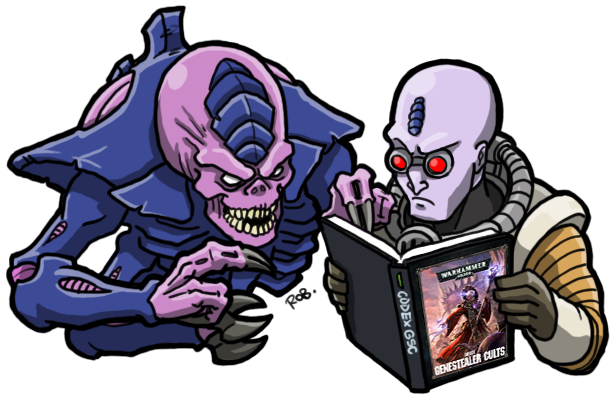
Mission Sequence Changes
The big changes to the mission sequence largely revolve around the other changes made by the Leviathan Tournament Companion. That is, the mission is no longer determined at random and is instead pulled from the Mission Pool in step 2. In Step 5 players use the guidelines from the terrain layouts section to create the battlefield. These are necessary adjustments to make things work with the other changes.
Objective Markers
In a change every competitive player was clamoring for, models can now end any type of move on top of an Objective Marker. This is huge, as 40mm objective markers take up a significant amount of space and could represent massive or sometimes impassable obstacles for vehicles and models with larger bases, making some terrain layouts nearly impossible to play on for those models. This becomes even more of an issue on missions where players may move objectives, such as when playing the Deploy Servo Skulls primary mission – a savvy player could opt to move objective markers in such a way as to block an opponent’s movement.
Objective Changes
While the rules from Leviathan are mostly used as-is when drawn upon, a very small number of Objectives (one Primary, two Secondary) have their scoring tweaked.
In Primary-land, Deploy Servo Skulls is changed so that the scoring from the conditions is not cumulative, meaning that punting an objective all the way into the opponent’s deployment zone is now only worth 8VP rather than 15VP. This is a good change – as it was, a single bad turn for one side could create a relatively insurmountable scoring lead, and this should ensure much tighter games.
For Secondaries, two of them are slightly improved when you hit their “medium” scoring criteria. Behind Enemy Lines now awards 3VP for getting a single unit into the enemy Deployment Zone rather than 2VP, and Deploy Teleport Homers awards 3VP for scoring it in the centre of the Battlefield. This looks to be aimed at buffing fixed objectives slightly – emerging consensus is that the combination of boosted cards and an extra CP on demand makes Tactical Objectives a consistently superior choice, and although this tweak looks pretty small, it does do a decent amount to shift the balance. These two Secondaries work very well together, and being able to play relatively cautiously with them on turn 1 and still get to 38VP at the end of the game (and still hit mid-thirties if you drop a couple more) makes them a bit more of a consideration. Honestly, hopefully not too much so – Tactical Objectives are fun, and most of us have had our fill of lists built to lock in a near unstoppable 90% score on Secondaries after Arks. It is a bit surprising to see these two synergistic choices buffed at the same time ahead of results, and there definitely does feel like there’s some risk of an overcorrection here.
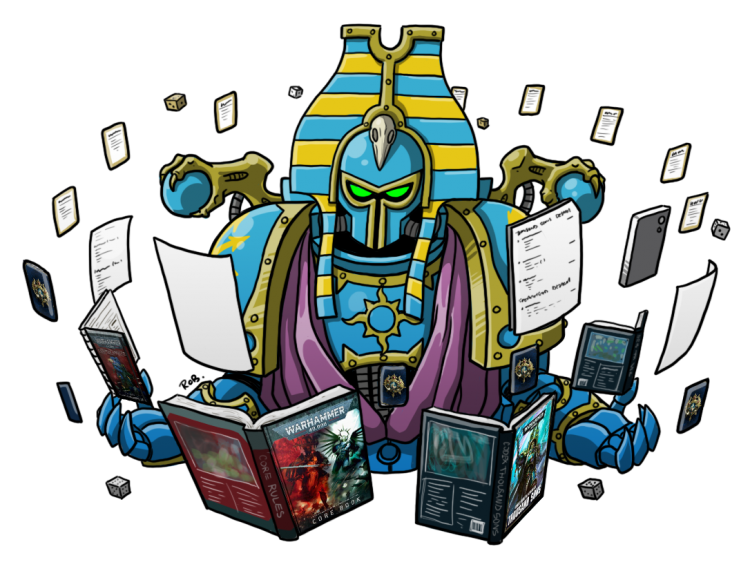
The Mission Pool
The Leviathan card deck provides a truly staggering number of possible combinations for missions, but anyone who’s been trying it out will know by now that some elements, particularly the Mission Rules, aren’t universally suited for competitive play, generally making things a bit too random or a bit too easy for skilled players to exploit. Some Primary options also play quite differently on the various deployment layouts that are available, and in a vacuum we’d have expected TOs to converge on some recommended Primary/Deployment pairings over time.
The suggested mission combinations get out ahead of both of these issues, and provide fifteen recommended combinations of Deployment, Primary Objective and Mission Rules that are particularly well tuned for tournament games. That’s still a surprisingly large variety, as 9th Edition GT packs generally capped out at nine different missions, so there’s plenty of different stuff for organisers to work with here, particularly if one or more missions end up being duds (think Nephilim Scouring). In addition to this, and in a bit of a first for Games Workshop, most missions also recommend that you specifically don’t use one of the four available terrain layouts with them, helping provide a bit of insight into what to avoid.
In order to pare down from the wide array of possibilities to this streamlined set of combinations, the biggest cuts have focused on mission rules, with only four of the rules in play, and nine of the fifteen missions featuring the Chilling Rain (i.e. no-effect) rule. The remaining three that see use are Hidden Supplies (the sixth objective), Chosen Battlefield (player-placed objectives) and one instance of Scrambler Fields (no Infiltrating, Scouting, Redeploy or Deep Striking onto objectives). Hidden Supplies makes a lot of sense, as it adds variety without shifting up the way the game plays, and while we don’t love rules like Scrambler Fields making it into competitive packs, 10th’s version of it is less of a complete no-sell than previous, and extending the restriction to Deep Strike/Redeploy ensures that more armies and more of the game are affected. We will also concede that pairing it with The Ritual, where only one objective starts on the table, minimises the extent to which it punishes bringing Infiltrators.
Chosen Battlefield is likely to be the really controversial one here, as although there’s some degree of curation in how objectives are placed, it very much provides an opportunity for a less experienced player to heedlessly sabotage themselves if they don’t understand what they’re doing (though the fact that it happens before Attacker/Defender roll-off means that there’s only so far you can go in skewing things). Some of our team played quite a bit of Maelstrom in 8th Edition, and player-placed objectives tended to be either a neutral or skewing factor, rarely one that really let one player’s skills shine through. It is, at least, paired with some fairly simple Primary Missions, so hopefully won’t cause any blowouts. It’s a pretty cautious approach to these overall, as ultimately with nine Chilling Rain options, there’s a decent chance that many TOs just bypass these entirely. To me, that suggests it would be sensible in the next mission pack (assuming there is one) to design up front half the mission rule cards to be competitive-targeted – a bit of variety is nice, but clearly most of the rules in Leviathan were deemed a bit risky for use.
Outside of Mission Rules, every option shows up – all nine Primary missions in different proportions, and all five deployment maps. For Primary Missions, the simplest like Take and Hold and Priority Targets turn up three times each, the two that mix up the Objective paradigm the most (Servo Skulls and The Ritual) make two appearances, and each of the rest once. For the standard five round GT or six round major there’s thus no need to repeat a Primary Mission, but interestingly the advice for longer events is to consider re-using some of the simpler ones with different maps rather than cycling through the whole set, so it will be interesting to see what the first GW open of 10th in Tacoma goes with. The depth of variety means that there probably isn’t a massive impact on experience from these, especially as the five Primary Missions that show up once are all paired with Chilling Rain, so no chance of them getting taken out of rotation by a bad pairing with Mission Rules. That said, it is a bit of a shame to see Scorched Earth and Purge the Foe relegated to one instance each, as both of these mix up some scoring dynamics in an interesting way that would have felt fine in place of the third instance of the two basic ones.
Deployment Maps also aren’t evenly distributed, with Search and Destroy/Crucible of Battle getting an extra slot each at the expense of Dawn of War/Sweeping Engagement. This feels like a smart decision if you’re aiming for a good mix of practicality and gameplay. While Dawn of War is the simplest deployment map out there, and easy to work with logistically in a tournament setting, it also tends to create some fairly skewed play patterns, more so than most other maps. Sweeping Engagement is similar enough (and also has the factor of having very limited ability to backline across a lot of the table) that it’s fair to give it the side-eye too. Favouring the corner maps over these is a good compromise – these still tend to be very practical in tournament settings, while giving more dynamic gameplay than Dawn of War.
How does this all end up coming together? The first key takeaway is that some of the games you play are going to be very simple – Mission A, which is Search and Destroy/Chilling Rain/Take and Hold has vastly less going on with it than pretty much any mission that existed across the whole of 9th, and there are a few others like this where you’re very much relying on the Tactical Objectives to provide variety. On the one hand, this makes tournament play very accessible, and avoids an over-prescriptive need to build for the missions, which should be great for onboarding new people to the scene. On the other, it feels like the end-product here ends up favouring lists that just want to body the opponent clean off the table a bit too hard, as not enough of these missions provide an angle on using sneaky techniques for Primary denial.
That’s a little bit of a shame, and could have been easily rectified by favouring Scorched Earth, Vital Ground and Supply Drop over the super-simple ones – these are all pretty intuitive and easy to learn, but skew the scoring more towards clever play in the mid board. Certainly when I (Wings) put together our pack for the Goonhammer Open UK (and stay tuned on that front) I’ll be dipping in to this set of missions rather than repeating the Take and Hold/Priority Target options.
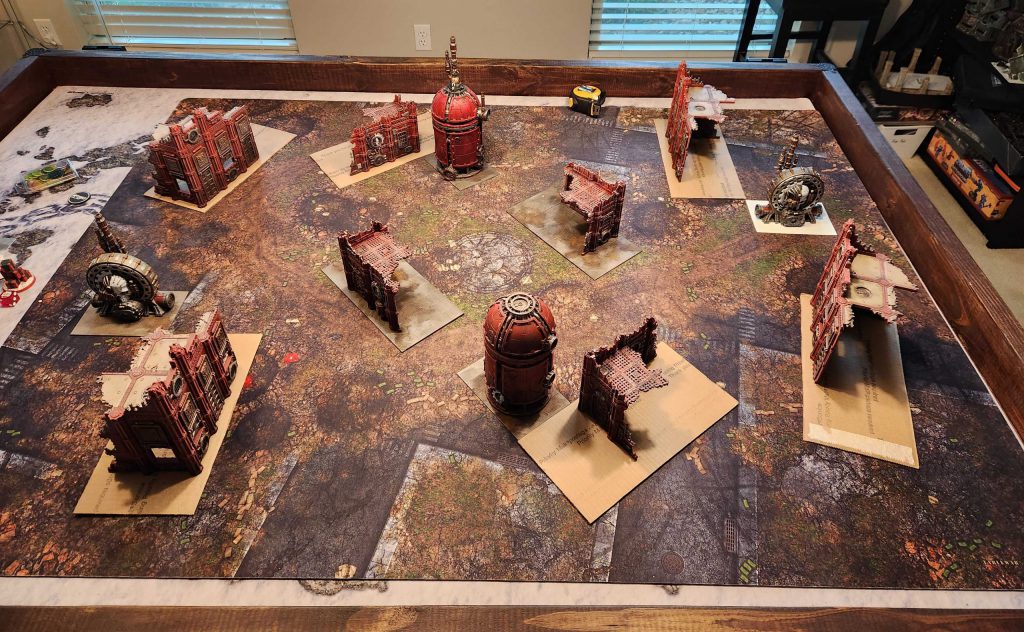
Terrain Layouts
In addition to mission recommendations, the LTC also creates recommendations for terrain layouts, and the document makes it clear that these are the layouts Games Workshop plans to use at their own events in the future.
There are three major things that GW points out as key principles in their terrain layouts, and they’re worth discussing:
- No Fixed Measurements: GW does not recommend or use fixed measurements for their terrain. There are a few reasons for this but one of the biggest is that GW doesn’t want players to be able to create precise game plans around terrain layouts, nor do they want to create weird situations in-game where someone calls for terrain to move two turns in because they noticed it was off-position. These are fair points, and a good rule of thumb for TOs to use.
- Objective Markers can be in terrain: Markers should never intersect a wall or other feature but can be in cover or behind walls. I’m generally of the mind that markers shouldn’t be visible from each other if you can help it, so this is a good guideline to have.
- Ruins: The GW layouts pretty much only use ruins. They recommend a variety of heights – though we’ll address that in a bit – and they recommend having larger elements to block True Line of Sight.
There are four recommended terrain layouts here. While there are no measurements provided for the terrain bases here – you are free to create your own or get close enough – savvy readers will guess (correctly) that these are intended to be mostly the same as the prior GW terrain bases, except that the 12”x12” bases have been bisected to create six 6”x12” bases instead. In that sense, these layouts will now use the following at GW events:
- Six 6”x12” bases
- Two 5”x10” bases
- Four 4”x6” bases
Splitting up the 12x12s creates a ton of additional flexibility in potential layouts and allows for the creation of layouts which are frankly much better than the GW Open layouts in 9th edition. While those layouts – Save #3 – weren’t terrible, these new layouts provide much better board coverage and do a much better job blocking sightlines across the board and between objective markers.
Something to Note: Layouts 1 and 4 have terrain features where two bases are placed in contact with each other. We have been informed that the intended use in these cases is to treat those as a single terrain base.This is not the case for terrain bases which only touch at a corner.
Wings: Including these recommendations is a fascinating step, and in general I think the average quality of these maps is significantly higher than in 9th. I’m not a massive fan of map 1, having tried it out, as I think it ends up being one where the shooting lanes for non-Towering stuff are just too constrained, but the rest look good, and I’m a particular fan of map 3. Will we be adopting these wholesale for the GHO? No – we’re still going to produce our own, but we’ll definitely be starting from the recommended layouts and varying from there using our terrain stash, and it’s hugely helpful as an event organiser to have this kind of recommendation to draw on. The only thing that I think is a bit of a shame is that the terrain is all ruins – I think one of the big strengths of 10th’s terrain rules is that small hills or bits of Battlefield Debris like statues now impact the game far more, and one of the places we’ll be deviating from these recommendations is by incorporating some of that.
TheChirurgeon: I’ve tried out maps 1 and 2 now, and I think I like Map 1 more than Wings but a lot of it boils down to which missions you’re playing on them. The corner-touching ruins are liable to create some real headaches for units with FLY if you aren’t careful about how you put down terrain, so keep that in mind when you’re placing terrain for these layouts. When it comes to these layouts, the part I struggle with most is the height guidelines; each map puts 5” tall ruins in player Deployment Zones, and while the intent is to block line of sight and hide units, these will also create a net effect of letting indirect units like Desolators deploy to the upper floor of a ruin and spend all game shooting indirect fire with the +1 AP boost from Plunging Fire. That’s not great.
Pairings and Rankings
Finally – and on a note intended purely for Tournament Organizers – the LTC provides guidelines for pairing and ranking players. These seem tailor-made for setting things up in Best Coast Pairings’ TO app, and they’re similar to recommendations we’ve made in the past:
- Pairings: Use Wins > Win Paths > Random. This helps ensure that players can’t get an advantage by “submarining” and manipulating their matchups by scoring fewer VP.
- Rankings: Use Wins > Opponent Game Win % (OGW) > VP. They recommend using total VP only as a last resort, and we agree, but we’d suggest that Win Paths be used ahead of OGW, especially at smaller events where three rounds do not give meaningful OGW scores. Either way, both are better than VP, which was already a terrible metric before we reintroduced random secondary objectives to the game.
This is pretty great guidance to give, and the sooner TOs and events move away from VP-based pairings and rankings, the better off everyone will be. Whether you’ve held on to them this far out of laziness (Wins>VP rankings are the BCP default) or just sheer obstinance, there has never been a better time to move on.
 Our Notes and Recommendations
Our Notes and Recommendations
We’re big fans of the LTC, and it’s great to see something like this out of Games Workshop as they’ve ramped up on their own events and become much more sure of their footing in the competitive space. A lot of these recommendations make sense, and we’ve been championing several of them for years already.
For TOs reading this and looking for further guidance we have some thoughts on how to use these guidelines and some additional thoughts on improving upon them:
- Make sure everyone’s playing the same mission each round. This one seems pretty obvious, but it’s worth saying out loud: If you’re running an event, give everyone the same mission combination each round.
- Consider picking a set of missions each day that use the same recommended layout. Unless you want to run around re-setting up terrain between rounds (you don’t), your best move as a TO of a two-plus day event is to pick a set of missions for each day which share a recommended layout, i.e. your day 1 missions can all use layout 3 and your day 2 missions can all use layout 2. This will let you mix up the missions while only having to move terrain around once.
- Keep an eye on Missions C, D, and K. These are the missions we’re the least sure about, for one reason or another. We’ll be watching the data on them pretty intently over the next few weeks, as these missions are clear outliers compared to the rest. If you’re running these at your events, keep an eye on the results and how they pan out for players.
Final Thoughts
This kind of guidance is great to have in the community, and it’s something we’d have liked to have seen out of Games Workshop sooner, given how eager stores and TOs were to adopt some kind of terrain layouts similar to the GW US Open events over the last two years. The recommended missions fix a lot of issues we had with the Leviathan Missions Pack, and the terrain layouts are a good evolution of the layouts published in 9th edition, which much better care taken to reduce sightlines between objectives. This is one of several tweaks we were hoping for to make 10th edition more competitively playable, and we’re glad to see it’s out.
A Note on Tabletop Battles
If you’re wondering when we’re going to drop support for this in Tabletop Battles well, good news! We’ve already updated the app to include support for this mode. The update is going live on Android apps right now and will go live in iOS apps when the app store finishes letting us update.
Have any questions or feedback? Drop us a note in the comments below or email us at contact@goonhammer.com.
